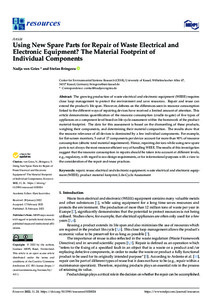| dc.date.accessioned | 2022-04-25T15:26:49Z | |
| dc.date.available | 2022-04-25T15:26:49Z | |
| dc.date.issued | 2022-02-21 | |
| dc.identifier | doi:10.17170/kobra-202204216060 | |
| dc.identifier.uri | http://hdl.handle.net/123456789/13780 | |
| dc.description.sponsorship | Gefördert durch den Publikationsfonds der Universität Kassel | ger |
| dc.language.iso | eng | eng |
| dc.rights | Namensnennung 4.0 International | * |
| dc.rights.uri | http://creativecommons.org/licenses/by/4.0/ | * |
| dc.subject | repair | eng |
| dc.subject | reuse | eng |
| dc.subject | electrical and electronic equipment | eng |
| dc.subject | waste electrical and electronic equipment (WEEE) | eng |
| dc.subject | product material footprint | eng |
| dc.subject | Life-Cycle Assessment | eng |
| dc.subject.ddc | 620 | |
| dc.title | Using New Spare Parts for Repair of Waste Electrical and Electronic Equipment? The Material Footprint of Individual Components | eng |
| dc.type | Aufsatz | |
| dcterms.abstract | The growing production of waste electrical and electronic equipment (WEEE) requires close loop management to protect the environment and save resources. Repair and reuse can extend the product’s life span. However, debates on the differences seen in resource consumption linked to the different ways of repairing devices have received a limited amount of attention. This article demonstrates quantification of the resource consumption (cradle-to-gate) of five types of appliances on a component level based on life-cycle assessment within the framework of the product-material-footprint. The data for this assessment is based on the dismantling of these products, weighing their components, and determining their material composition. The results show that the resource relevance of all devices is dominated by a few individual components. For example, for flat-screen monitors, 5 out of 17 components per device account for more than 90% of resource consumption (abiotic total material requirement). Hence, repairing devices while using new spare parts is not always the most resource-efficient way of handling WEEE. The results of this investigation suggest that the resource consumption in repairs should be taken into account at different levels, e.g., regulatory, with regard to eco-design requirements, or for informational purposes with a view to the consideration of the repair and reuse practices. | eng |
| dcterms.accessRights | open access | |
| dcterms.creator | Gries, Nadja von | |
| dcterms.creator | Bringezu, Stefan | |
| dc.relation.doi | doi:10.3390/resources11020024 | |
| dc.subject.swd | Reparatur | ger |
| dc.subject.swd | Wiederverwendung | ger |
| dc.subject.swd | Elektrogerät | ger |
| dc.subject.swd | Elektronikschrott | ger |
| dc.subject.swd | Material | ger |
| dc.subject.swd | Ökologischer Fußabdruck | ger |
| dc.subject.swd | Umweltbilanz | ger |
| dc.type.version | publishedVersion | |
| dcterms.source.identifier | eissn:2079-9276 | |
| dcterms.source.issue | Issue 2 | |
| dcterms.source.journal | Resources | eng |
| dcterms.source.volume | Volume 11 | |
| kup.iskup | false | |
| dcterms.source.articlenumber | 24 | |


